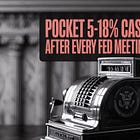My post on how I extract $77K a year from every $500K—My Ultimate 2025 Retirement Income System for 2025—was a hit, and I’m thrilled it resonated with so many readers.
But it also brought in a wave of new subscribers with sharp questions—so I pulled everything together into this quick FAQ and strategy guide.
In less than 5 minutes, you'll understand the core system.
I’ll show you how options can turbocharge your retirement income—without taking on wild risks.
This is the shortcut I wish I had when I started.
1. OK, so what is The Multiplier, in one minute?
The Multiplier is a step‑by‑step plan that turns regular stocks into a steady paycheck.
It does three big things all at once:
Own good companies that pay and grow dividends.
Sell options on those shares to pull in extra cash every month.
Re‑invest the cash to buy even more shares—so next month’s cash is bigger.
That loop repeats, and the cash flow grows like a snowball rolling downhill.
2. The four “bucket” portfolio system (your master checklist)
Every stock you hold should live in one of these buckets.
Each bucket has a job.
Blend all four and you get both safety (buckets 1–3) and high monthly cash (bucket 4).
3. How the Multiplier snowball grows your paycheck
Collect option premium → Cash drops into your account today.
Buy more shares with that cash → Your next dividend checks get bigger.
Sell options on the new shares → You pocket even more premium.
Repeat → Each round stacks on the last—small at first, huge later.
Example: Your first month’s premiums buy just 4 extra shares. Those 4 become 6, then 10, then 20 as the loop repeats.
4. Can a $500k account really make about $77k a year?
Yes—if you combine dividends and option premiums week after week.
Option buyers tend to overpay for peace of mind, like extended warranties. We sell that “insurance” and keep the difference.
$500,000 traditional 60/40 portfolio → dividends $10,000 + bond interest $8,000 = $18,000/year ($1,500/month)
$500,000 with the Multiplier strategy + VADER→ dividends $17,500 + options premiums $60,000 = $77,500/year ($6,458/month)
That’s a 4.3× income multiplier—an extra $59,500 annually—while simultaneously reducing risk because every premium you collect lowers your cost basis.
5. What exactly happens when I sell an option?
Think of options the same way you think about car insurance.
A tiny scratch on your Toyota rarely triggers a claim because the deductible is higher than the repair cost.
Most drivers pay premiums that never get used, and the insurance company keeps the money.
Selling options works the same way—you can be the insurance company and pocket those premiums.
By learning to sell that "insurance" on shares you already own, you step into the role of the insurer, not the insured:
Covered Call (CC) – You own 100 shares. You get paid today to promise you’ll sell those shares later at a “strike” price. If the stock never reaches that price, you just keep the cash. If it does, you sell for the profit you picked.
Cash‑Secured Put (CSP) – You keep enough cash ready to buy 100 shares. You get paid today to promise you’ll buy the shares at the strike if the other person wants to sell. If the stock never falls that low, you keep the cash.
Your broker checks that you really have the shares (for a CC) or cash (for a CSP).
So your worst‑case is owning stock you already like—or buying it at a discount you approved.
6. Show me one full trade, step by step
Example: Johnson & Johnson (JNJ)
Own 100 JNJ @ $152
Sell JNJ 160 call (40 days) for $2.10
Up-front cash: $210 → 16.5% annualized
If JNJ spikes, you still bank the gain up to $160 plus the dividend
If it drifts, you keep the shares and the premium
Possible Outcomes:
Scenario 1: JNJ stays below $160
The option expires worthless; You keep your shares, the premium, and any dividends. You can sell another covered call and repeat.
Scenario 2: JNJ rises above $160
Your shares get called away at $160. You keep the premium and any dividends
Your total gain is ($160 - $152) + $2.10 = $10.10 per share (6.6% in 40 days)
Either way, you’re up.
7. How We Pick Winning Trades (VADER in 60 Seconds)
VADER stands for Volatility Arbitrage Dividend Enhancement Return system.
It's the proprietary screening algo we developed with the dev team during my trading years to identify the ideal option-selling candidates.
It has followed me from the trading desk to my home office.
What VADER Does in Plain English
Scans every night 3,217 optionable stocks, filtering for 16 specific criteria, including liquidity thresholds, volatility patterns, and technical support levels.
Filters out weak or risky names (bad balance sheets, thin trading, surprise earnings).
Scores what’s left on safety and premium, then drops each ticker into three simple lists: 🔒Conservative, ⚖️Balanced, 🔥Aggressive.
Delivers ready‑to‑trade lists:
🟢 Top Cash‑Secured puts every Thursday
🔵 Best Covered‑Call setups every Sunday
You’ll also see a new “Option Income” tab on the web version of The Multiplier. All the VADER lists, explainers, and walk‑through posts live in that one hub—everything in one place for fast reference.
Latest VADER picks you might have missed:
(Click after you finish this guide and paper‑trade a couple of ideas.)
8. How do I pick the best strike price?
Look at Delta, which is shown next to every option.
It’s the rough percent chance the buyer will act.
When market fear (VIX) spikes, premiums get fat—so you can use lower deltas and still get paid.
9. What if the stock moves a lot after I sell the option?
10. Is This Safe for Retirement Money?
Selling CCs and CSPs often lowers risk because you collect cash first. Twenty‑year back‑tests show shallower drawdowns—if you obey the size rules.
11. How much time will this take each week?
Many readers set Good‑Til‑Canceled exits so their broker locks profits automatically, cutting screen time almost in half.
12. What gear do I need to start?
Broker approval for “Level 2 Options” (check “income generation”).
$25,000 or more so you can control at least one 100‑share lot.
A free trading app—Fidelity, Schwab, or TD Ameritrade all show option chains.
90 minutes a week: 30–45 min Thursday (puts), 30–45 min Sunday (calls), 10 min mid‑week check.
Tip: Put two repeating reminders in your calendar so you never forget trade days.
13. Your Next Moves
Request Level 2 options from your broker (free).
Paper‑trade the next two VADER lists—no real money yet.
Go live with one Dividend‑Growth stock and a mild‑delta call.
Go Premium if you want full access to the VADER feed—Covered Calls on Sunday and Cash‑Secured Puts on Thursday, or read this if you want to mimic it on your own:
See you Thursday with the next Cash‑Secured Puts ladder!
P.S. I'll pin this post on the web version of The Multiplier so you can get back to it anytime you need.
Thank you for tuning in today and supporting my work!
Mike Thornton, Ph.D.

















